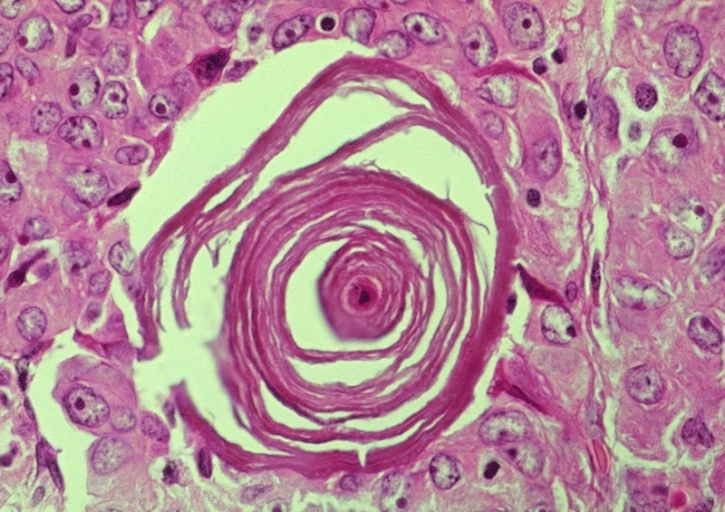WBR0863: Difference between revisions
Jump to navigation
Jump to search
No edit summary |
Sergekorjian (talk | contribs) No edit summary |
||
| Line 1: | Line 1: | ||
{{WBRQuestion | {{WBRQuestion | ||
|QuestionAuthor={{Rim}} (Reviewed by Will Gibson) | |QuestionAuthor={{Rim}} (Reviewed by Will Gibson & Serge Korjian) | ||
|ExamType=USMLE Step 1 | |ExamType=USMLE Step 1 | ||
|MainCategory=Pathology | |MainCategory=Pathology | ||
| Line 25: | Line 25: | ||
[[Image:WBR0863.jpg|450px]] | [[Image:WBR0863.jpg|450px]] | ||
|Explanation=Mesothelioma is a malignant tumor of the lung pleura associated with exposure to asbestos. Typically patients present with dyspnea, pleuritic chest pain, and weight loss. Patients can also have significant pleural effusions that are often hemorrhagic. Pathologically the tumor begins as discrete thickened plaques along the pleura that eventually coalesce into a single neoplasm. A characteristic finding in mesothelioma is psammoma bodies. Psammoma bodies are whorl shaped structures composed of calcium that are the result of tumor cell necrosis with associated dystrophic calcification. Psammoma bodies can be seen in other tumors as well including papillary thyroid carcinoma, ovarian serous cystadenocarcinoma, and meningioma. | |Explanation=Mesothelioma is a malignant tumor of the lung pleura associated with exposure to asbestos. Typically patients present with dyspnea, pleuritic chest pain, and weight loss. Patients can also have significant pleural effusions that are often hemorrhagic. Pathologically the tumor begins as discrete thickened plaques along the pleura that eventually coalesce into a single neoplasm. A characteristic finding in mesothelioma is psammoma bodies. Psammoma bodies are whorl shaped structures composed of calcium that are the result of tumor cell necrosis with associated dystrophic calcification. Psammoma bodies can be seen in other tumors as well including papillary thyroid carcinoma, ovarian serous cystadenocarcinoma, and meningioma. Tumors that cause psammoma bodies are memorized by the mnemonic '''PSaMMoma''': Papillary thyroid cancer - Serous cystadenocarcinoma of the ovaries - Meningioma - Mesothelioma | ||
Tumors that cause psammoma bodies are memorized by the mnemonic PSaMMoma: Papillary thyroid cancer - Serous cystadenocarcinoma of the ovaries - Meningioma - Mesothelioma | |||
|AnswerA=Tumor cell proliferation | |AnswerA=Tumor cell proliferation | ||
|AnswerAExp=This is not the mechanism involved in the formation of psammoma bodies. | |AnswerAExp=This is not the mechanism involved in the formation of psammoma bodies. | ||
| Line 42: | Line 40: | ||
|RightAnswer=E | |RightAnswer=E | ||
|WBRKeyword=Psammoma bodies, Mesothelioma, Dystrophic calcification | |WBRKeyword=Psammoma bodies, Mesothelioma, Dystrophic calcification | ||
|Approved= | |Approved=Yes | ||
}} | }} | ||
Revision as of 22:39, 5 March 2015
| Author | [[PageAuthor::Rim Halaby, M.D. [1] (Reviewed by Will Gibson & Serge Korjian)]] |
|---|---|
| Exam Type | ExamType::USMLE Step 1 |
| Main Category | MainCategory::Pathology |
| Sub Category | SubCategory::Pulmonology |
| Prompt | [[Prompt::A 82-year-old retired marine corps veteran presents to the pulmonary clinic for 2 weeks of unremitting cough and pleuritic chest pain. The patient reports a 20 pound unintentional weight loss in the past 2 months and slowly increasing dyspnea. Due to the high suspicion for malignancy the physician orders a CT scan that shows obliteration of parts of the diaphragm with diffuse nodular thickening of the pleura. He admits the patient for a diagnostic biopsy. The pathologist notices several whorl-like structures on biopsy shown below. What pathologic mechanism is responsible for the formation of these structures? |
| Answer A | AnswerA::Tumor cell proliferation |
| Answer A Explanation | AnswerAExp::This is not the mechanism involved in the formation of psammoma bodies. |
| Answer B | AnswerB::Tumor cell apoptosis and structured accumulation |
| Answer B Explanation | AnswerBExp::This is not the mechanism involved in the formation of psammoma bodies. Apoptosis is usually inhibited in tumor cells. |
| Answer C | AnswerC::Tumor cell destruction by the activated T-cells |
| Answer C Explanation | AnswerCExp::This is not the mechanism involved in the formation of psammoma bodies. |
| Answer D | AnswerD::Tumor cell de-differentiation and invasion |
| Answer D Explanation | AnswerDExp::This is not the mechanism involved in the formation of psammoma bodies. |
| Answer E | AnswerE::Tumor cell necrosis with dystrophic calcification |
| Answer E Explanation | AnswerEExp::Psammoma bodies are calcium structures formed due to tumor cell necrosis and dystrophic calcification. |
| Right Answer | RightAnswer::E |
| Explanation | [[Explanation::Mesothelioma is a malignant tumor of the lung pleura associated with exposure to asbestos. Typically patients present with dyspnea, pleuritic chest pain, and weight loss. Patients can also have significant pleural effusions that are often hemorrhagic. Pathologically the tumor begins as discrete thickened plaques along the pleura that eventually coalesce into a single neoplasm. A characteristic finding in mesothelioma is psammoma bodies. Psammoma bodies are whorl shaped structures composed of calcium that are the result of tumor cell necrosis with associated dystrophic calcification. Psammoma bodies can be seen in other tumors as well including papillary thyroid carcinoma, ovarian serous cystadenocarcinoma, and meningioma. Tumors that cause psammoma bodies are memorized by the mnemonic PSaMMoma: Papillary thyroid cancer - Serous cystadenocarcinoma of the ovaries - Meningioma - Mesothelioma Educational Objective: Psammoma bodies are formed due to tumor cell necrosis and dystrophic calcification. |
| Approved | Approved::Yes |
| Keyword | WBRKeyword::Psammoma bodies, WBRKeyword::Mesothelioma, WBRKeyword::Dystrophic calcification |
| Linked Question | Linked:: |
| Order in Linked Questions | LinkedOrder:: |
